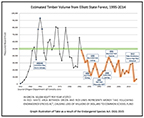2018 SWOCC Elliott State Forest Draft Recreation Plan
Two Old-Growth. Jerry Phillips points out two pre-1868 Fire Douglas fir trees within Huckleberry Point conifer stand to 2018 Southwestern Oregon Community College (SWOCC) spring term forestry students, instructor, and field guides during May 15, 2018 Loon Lake Field Trip. Photo by Anne Farrell-Matthews, SWOCC Communications Director.
Elliott Forest Recreation Homepage: http://www.ORWW.org/Elliott_Forest/Recreation/
Citation: Amy Kronsberg, Tara Boyd, Maggie Boone, Cole Smith, Daniel Patton, Carter Carr, Matthew Hofenbridl, Maxwell Richcreek, Matthew Smith, Abigail Richards, Cody Harkins, and Scott Guthrie 2018. 2018 Draft Elliot State Forest Recreation Plan. Oregon Websites & Watersheds Project, Inc., Philomath, Oregon: 65 pp. [PDF: 7 MB].
Acknowledgements: This report could not have been completed without the assistance and guidance of several knowledgeable individuals and their organizations for classroom presentations, field trip leadership, and personal consultations: Peggy Croce, Loon Lake Lodge and RV Resort; Anne Farrell-Matthews, Southwestern Oregon Community College; Marty Giles, Wavecrest Discoveries; David Gould (ret.), Coos Bay Timber Operators, Inc.; Mike Mader, Tenmile Lakes Basin Partnership; Bob Mahaffy, Mahaffy Tree Farm, Inc.; Jerry Phillips (ret.), Elliott State Forest Manager; Cathy Reiss, Ringo’s Lakeside Marina; Amber Ross, Oregon Department of State Lands; Gordon Ross, former Coos County Commissioner; Antonio Salgado, Oregon Department of Fish & Wildlife Coos Watershed Salmon & Trout Enhancement (STEP) Program; Barbara Taylor, Cape Arago Audubon Society; Gary Vonderohe, Oregon Department of Fish & Wildlife; Bob Zybach, Oregon Websites & Watersheds Project, Inc. (ORWW).
ORWW Mission Statement: Oregon Websites & Watersheds Project, Inc. (ORWW) is a 501 c(3) Oregon nonprofit organization and educational website founded in 1996 to provide quality environmental science and computer technology education for Oregon schools and communities. The primary mission of the organization is to instruct Oregon students, teachers, and residents in the use of computer technology, historical documentation, scientific reasoning, community consensus building, environmental enhancement projects, and long-term monitoring strategies for the purpose of making decisions regarding the management of local natural and cultural resources.
| Introduction. By Amy Kronsberg | |
| Chapter 1. Roads and Trails. By Tara Boyd, Matthew Smith, and Daniel Patton | |
Chapter 2. Local Forest Recreation Opportunities. By Amy Kronsberg, Scott Guthrie, and Maggie Boone |
|
| Chapter 3. Camping. By Maggie Boone, Amy Kronsberg, and Scott Guthrie | |
| Chapter 4. Elliott Forest History. By Cole Smith, Carter Carr, and Maxwell Richcreek | |
| Chapter 5. Sightseeing and Aesthetics. By Daniel Patton, Tara Boyd, and Matthew Smith | |
| Chapter 6. Cultural Resources. By Carter Carr, Maxwell Richcreek, and Cole Smith | |
| Chapter 7. Fish Hatcheries. By Matthew Hofenbredl, Abigail Richards, and Cody Harkins | |
| Chapter 8. Fish Habitat and Recreational Fishing Access. By Maxwell Richcreek, Cole Smith, and Carter Carr | |
| Chapter 9. Birds and Birding. By Matthew Smith, Daniel Patton, and Tara Boyd | |
| Chapter 10. Hunting and Trapping. By Abigail Richards, Cody Harkins, and Matthew Hofenbredl | |
| Chapter 11. Ethnobotany. By Cody Harkins, Matthew Hofenbredl, and Abigail Richards | |
 |
Chapter 12. Forest Recreation Economics. By Scott Guthrie, Amy Kronsberg, and Maggie Boone |
| Recommendations. | |
| References. | |
| Appendix. Elliott Forest Educational Field Trips | |
| Figures. | |
| Maps. |
© 2017, 2018 Oregon Websites & Watersheds Project, Inc. & NW Maps Co.